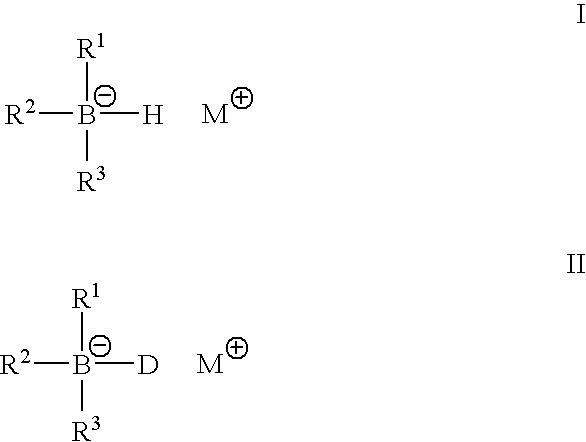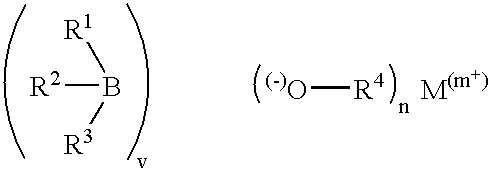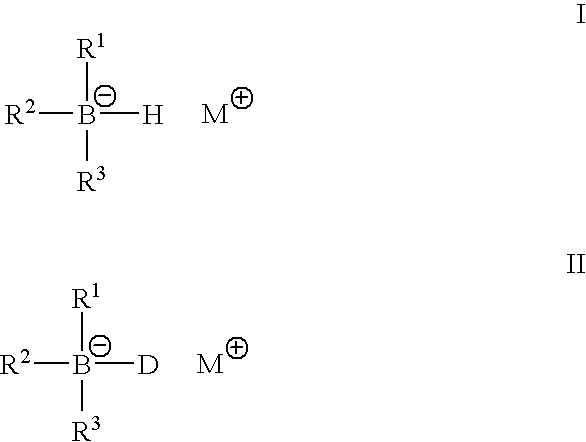Metal alkyl borphydride polymerisation initiators, polymerisable compositions, and uses thereof
a technology of metal alkyl borphydride and initiator, which is applied in the direction of cellulose adhesive, synthetic resin layered products, adhesives, etc., can solve the problems of inconvenient manufacturing of such complexes, poor shelf stability, and difficulty in manufacturing such complexes, so as to improve the impact resistance and peel resistance of the bond, and maintain the effect of adhesive strength
- Summary
- Abstract
- Description
- Claims
- Application Information
AI Technical Summary
Benefits of technology
Problems solved by technology
Method used
Image
Examples
example 1
Initiator Component (Part A)
A lithium triethyl borohydride solution (2 g) (1 molar in tetrahydrofuran) was mixed with trimethylolpropane tris(3-(2-methylaziridino))propionate (3 g).
Adhesive Component (Part B)
A slurry comprising a core-shell toughener (50 g), available commercially under the tradename Blendex 336 from GE Speciality Chemicals, tetrahydrofurfuryl methacrylate (125 g), 2-ethylhexyl methacrylate (42 g) and 2-acryloyloxyethyl maleate (34 g) was stirred with a high shear mixer for several hours until a homogeneous dispersion was obtained.
The initiator component A (5g) and adhesive component B (45g) were packaged respectively into the two syringes of a MIXPAC System 50 1:10 volume ratio 50 ml dual syringe applicator having a 1:10 volume ratio between the syringes holding the components A and B respectively. The two components were mixed by the simultaneous extrusion through a 17 stage static mixer nozzle. The mixed adhesive composition was tested on a range of subst...
example 2
Initiator Component (Part A)
A lithium triethyl borohydride solution (2 g) (1 molar in tetrahydrofuran) was mixed with trimethylolpropane tris(3-(2-methylaziridino))propionate thickened with 30% by weight of Propoxylated Bisphenol-A Fumarate polyester(3 g).
Adhesives were prepared and evaluated using the aforementioned initiator component and the adhesive component B from Example 1, to give the following results.
3 Kg FixtureShear StrengthstimesSubstratesMPaMinutesMild Steel / Polyethylene3.75*13Mild Steel / Polypropylene4.65*12Polycarbonate / Polycarbonate5.0n / aPolypropylene / Polypropylene4.1**11Polyethylene / Polyethylene3.312*Many of the bonded assemblies slipped from the Instron jaws before the bonds broke **Most of the bonded assemblies slipped from the Instron jaws before the bonds broke
The 3 Kg fixture times are the minimum cure times after bond assembly at which a bonded assembly will support a 3 Kg weight for a minimum of 10 seconds.
example 3
Initiator Component (Part A)
The initiator component was prepared as outlined in Example 2.
Adhesive Component (Part B)
A slurry comprising a core-shell toughener Blendex 360 (100 g), tetrahydrofurfuryl methacrylate (249.5 g), 2-ethylhexyl methacrylate (83.2 g) and 2acryloyloxyethyl maleate (67.3 g) was stirred with a high shear mixer for several hours until a homogeneous dispersion was obtained.
Adhesive
A mixed adhesive composition was prepared as outlined in Example 1. The mixed adhesive composition was tested on a range of substrates as outlined in earlier examples. The bonds strengths for two sets of tests are presented in the table below.
3 Kg FixtureShear StrengthstimesSubstratesMPaMinutes(i) 0.5 inch (12.7 mm) overlapPolyethylene / Polyethylene3.7*12Polypropylene / Polypropylene4.2*12.5Mild Steel / Polyethylene3.210Mild Steel / Polypropylene3.210.5Polycarbonate / Polycarbonate4.610.5Mild Steel / Mild Steel6.912*Many of the bonded assemblies slipped from the Instron jaws before the bonds broke...
PUM
| Property | Measurement | Unit |
|---|---|---|
| surface energy | aaaaa | aaaaa |
| composition | aaaaa | aaaaa |
| weight | aaaaa | aaaaa |
Abstract
Description
Claims
Application Information
 Login to View More
Login to View More - R&D
- Intellectual Property
- Life Sciences
- Materials
- Tech Scout
- Unparalleled Data Quality
- Higher Quality Content
- 60% Fewer Hallucinations
Browse by: Latest US Patents, China's latest patents, Technical Efficacy Thesaurus, Application Domain, Technology Topic, Popular Technical Reports.
© 2025 PatSnap. All rights reserved.Legal|Privacy policy|Modern Slavery Act Transparency Statement|Sitemap|About US| Contact US: help@patsnap.com



